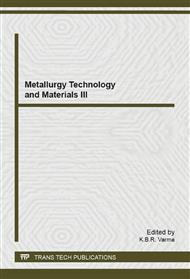[1]
Chen Jianfeng. The high gravity technology and it application [M], chemical industry preess, Beijing, (2003).
Google Scholar
[2]
Liu Youzhi. High gravity chemical process and technology [M], the Defense Industry Press, Beijing, (2009).
Google Scholar
[3]
Zou Haikui, Shao Lei, Chen Jianfeng. Progress in high gravity technology from the laboratory to industrial [J]. Journal of chemical industry and engineering, 2006, 57 (8): 1810-1816.
Google Scholar
[4]
Xu Ming, Zhang Jianwen, Shen Zhigang. Numerical simulation of gas-liquid two-phase flow and mass transfer in a rotating packed bed [J]. Journal of Beijing University of Chemical Technology, 2004, 5: 30-35.
Google Scholar
[5]
Xu Chunyan, Liu Chengbin, Shi Litian, etc. Experimental analysis for the temperature distribution in the packing of RPB [J]. Journal of Beijing University of Chemical Technology, 2005, 3: 23-26.
Google Scholar
[6]
Yang Haijian, Zhang Jianwen, Miao Jianrui, etc. Study on Turbulent Micromixing in a Tubular Packed Bed Reactor[J] . Journal of chemical engineering of Chinese universities, 2006, 3: 390-394.
Google Scholar
[7]
Liu Youzhi, Liu Zhenhe, Kang Rongcan, etc. Characteristics of gas pressure drop in cross-flow rotating-packed bed [J]. Journal of chemical industry and engineering, 2007, 4: 869-875.
Google Scholar
[8]
Jiao Weizhou, Liu Youzhi, Qi Guisheng, etc. Effective Interfacial Area of High Gravity Rotating Packed Bed [J]. Chemical reaction engineering and technology, 2007, 23(4): 296-301, 369.
Google Scholar
[9]
Sui Litang, Xu Zhichao, Yu Yunliang, etc. Influence of the Rotor Structure of Rotating Zigzag Bed on Gas Pressure Drop [J]. Journal of chemical engineering of chinese universities, 2008, 22(1): 28-33.
Google Scholar
[10]
Li Xiuping, Liu Youzhi, Li Jihong, etc. Preliminary studies on the super gravity continuous distillation[J]. Modern chemical industry, 2008, 28(z1): 75-77, 79.
Google Scholar
[11]
Xiang Yang, Chen Jianfeng, Gao Zheng Ming. Modelling and experimental validation of micromixing in rotating packed bed[J]. Journal of chemical industry and engineering(china), 2008, 59(8): 2021-(2026).
Google Scholar
[12]
Zhang Jianwen Li Yachao Chen Jianfeng. Characteristics of micromixing and reaction in a rotating bed[J]. CIESC Journal, 2011, 62(10): 2726-2732.
Google Scholar
[13]
Sun Qian, Chu Guangwen, Zou Haikui et al. Micromixing Efficiency of an Impinging Stream-Helical Tube Reactor [J]. Journal of Chemical Engineering of Chinese Universities, 2012, 26(4): 558-562.
Google Scholar
[14]
Shi Xin, xiangyang, Wen Lixiong, etc. Analysis of Flow Field for Rotating Packed Bed Based on the Discrete Phase Model [J]. Journal of Chemical Engineering of Chinese Universities, 2012, 26(3): 388-394.
Google Scholar
[15]
Zhang Jianwen, Gao Dongxia, Li Yachao et al. Research progress of multiphase transport in high gravity environment in rotating packed bed [J]. CIESC Jorunal, 2013, 64(1): 243-251.
Google Scholar
[16]
Yin Yujun Zhao Zhongmin Zhang Long. Fine-grained TiC- (Ti, W) C Matrix Ceramics Prepared by Combustion Synthesis under High Gravity [J]. Journal of Materials Engineering, 2010, z2: 134-137.
Google Scholar
[17]
Liu Guanghua, Li Jiangtao, Chen Yixiang, etc. SeIf-Propagating High—Temperature Synthesis(SHS)of Ti-Containing Ceramic Composites under Ultra-High Gravity [J]. Rare Metal Materials and Engineering, 2011, z1: 262-264.
Google Scholar
[18]
Huang Xuegang, Zhang long, Zhao Zhongmin, etc. Microstructure and properties of solidified TiC TiB2 composites prepared by combustion synthesis in high-gravity field [J]. Acta Materiae Compositae Sinica, 2012, 5: 77-85.
Google Scholar
[19]
Sun Xiangming, Song Yuepeng, Gao Dongsheng, etc. Adiabatic temperature calculation and microstructure of W-Cu alloy fabricated by combustion synthesis infiltration technique under ultra-gravity field [J]. Transactions of Materials and Heat Treatment, 2013, 6:158-162.
Google Scholar
[20]
Wang He, Liu Youzhi, Diao Jinxiang etc. O3/H2O2 Oxidative Treatment of TNT Red-Water in a Rotating Packed Bed [J]. Chinese Journal of Energetic Materials, 2007, 11:61-65.
Google Scholar
[21]
Li Peng, Liu Youzhi, Li Yu etc. Research on Treatment of Nitrogen Oxides in Explosive Industry by Rotating Packed Bed with NaOH Solution [J]. Chinese Journal of Energetic Materials, 2007, 3:277-280.
Google Scholar
[22]
Zhang Lei, Gao Hua, Zou Haikui etc. Preparation of butyl rubber by new high-gravity technology[J]. Journal of Chemical Industry and Engineering(China), 2008, 1:260-263.
Google Scholar
[23]
Wang Jun , Zou haiKui , Chu Guangwen, etc. Study of Flue Gas Desulfurization in Rotating Packed Bed [J]. Journal of Chemical Engineering of Chinese Universities, 2011, 1:168-171.
Google Scholar
[24]
Liu Ting, Guo Zhancheng, Wang Zhi etc. Structure and properties of electrochemically deposited nickel under high gravity field [J]. The Chinese Journal of Nonferrous Metals, 2008, 10: 1858-1863.
Google Scholar
[25]
Li Jingwei, Guo Zhancheng, Tang Huiqing etc. Si purification by solidification of Al-Si melt with super gravity [J]. Transactions of Nonferrous Metals Society of China, 2012, 4: 958-963.
DOI: 10.1016/s1003-6326(11)61270-3
Google Scholar


